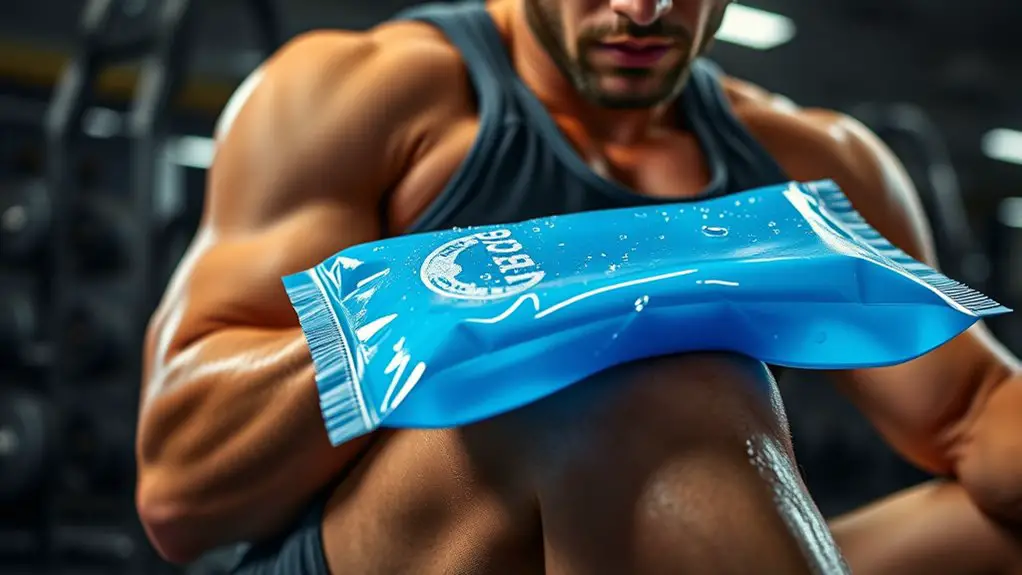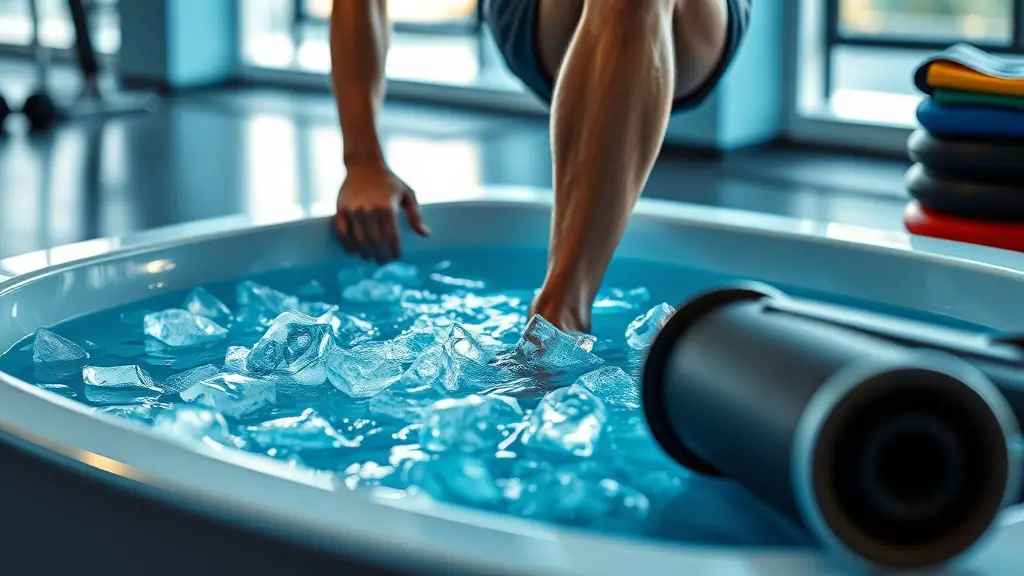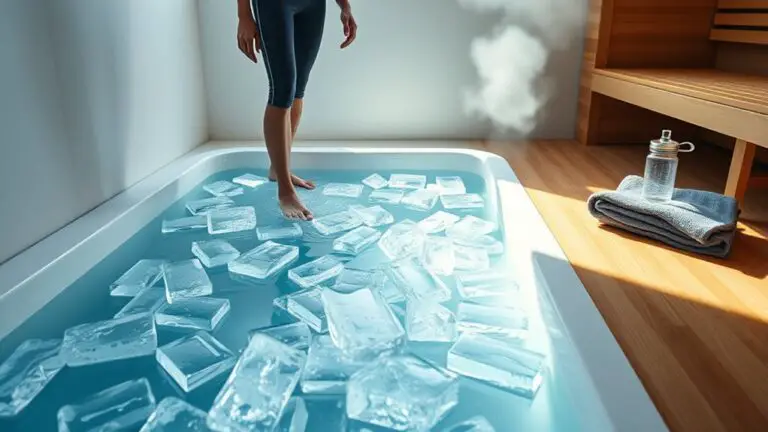How to Use Cold Therapy for Gym Recovery

To use cold therapy for effective gym recovery, apply ice packs or cold baths within 30 minutes post-exercise for 10-20 minutes to reduce inflammation and muscle soreness. Make sure ice packs are wrapped in cloth to prevent skin damage, and limit exposure to avoid tissue harm. Incorporate this method with hydration and proper nutrition to enhance its benefits. By understanding ideal practices and timing, you can maximize recovery outcomes and improve your performance. Further insights follow.
Understanding Cold Therapy

Cold therapy, often referred to as cryotherapy, is a recovery technique that involves exposing the body to low temperatures to alleviate muscle soreness and reduce inflammation post-exercise. The history of cold therapy dates back to ancient civilizations, where ice and snow were used for therapeutic purposes. Despite its long-standing presence, several misconceptions persist. Many believe that cold therapy solely numbs pain, but research indicates it also modulates inflammatory responses and promotes recovery by constricting blood vessels, which reduces swelling. Additionally, some argue that cold therapy can hinder muscle growth, yet studies suggest it may actually enhance recovery without negatively impacting muscle hypertrophy when used appropriately. Understanding these nuances is essential for effectively integrating cold therapy into your recovery routine. By dispelling myths and acknowledging its historical context, you can make informed decisions about your post-exercise recovery strategy.
Types of Cold Therapy Methods
There are several effective methods of cold therapy available for gym recovery, each with unique advantages. Ice packs are a common choice for localized cooling, providing targeted relief to specific muscle groups. Cryo chambers, on the other hand, expose your entire body to extreme cold, potentially enhancing recovery through systemic effects. Cold baths are also popular; immersing yourself in cold water can reduce overall body temperature and inflammation. Gel wraps offer convenience, allowing you to apply cold therapy to affected areas while maintaining mobility. Ice massages combine the benefits of massage with cold exposure, promoting blood flow while numbing soreness. Cold compresses serve as an easy at-home option for quick relief. Additionally, contrast therapy, which alternates between hot and cold applications, may enhance circulation and recovery. Each method has its specific use cases, making it essential to choose what aligns best with your recovery needs.
Benefits of Cold Therapy for Recovery

Cold therapy is proven to reduce muscle inflammation, which can greatly impact your overall recovery process. By constricting blood vessels and decreasing metabolic activity, it helps minimize swelling and tissue damage. This accelerated recovery can enhance your performance in subsequent workouts, allowing you to train more effectively.
Reduces Muscle Inflammation
When engaging in intense workouts, your muscles often experience micro-tears and inflammation, which can hinder recovery. Cold therapy is an effective method for inflammation reduction, directly addressing muscle soreness and promoting healing. By applying cold to the affected areas, you can achieve several benefits:
- Vasoconstriction: Cold temperatures narrow blood vessels, reducing blood flow and decreasing inflammation.
- Nerve Signal Disruption: Cold exposure can disrupt pain signals, leading to a temporary reduction in muscle soreness.
- Metabolic Rate Decrease: Lowering the temperature can slow down the metabolic processes in muscles, minimizing further damage.
Utilizing cold therapy post-workout allows your body to recover more effectively, alleviating soreness and inflammation, and ultimately enhancing your overall performance.
Enhances Recovery Speed
Following the reduction of inflammation, cold therapy also greatly enhances recovery speed. Cold exposure constricts blood vessels and reduces metabolic activity, which not only limits swelling but also expedites the healing process. Studies indicate that athletes who incorporate cold therapy into their recovery protocols experience a notably shorter recovery timeline compared to those who don’t. This accelerated recovery is due in part to improved lymphatic drainage and reduced muscle soreness, which allows you to return to training more quickly. In addition, cold exposure can enhance muscle repair by promoting the release of growth factors. By effectively integrating cold therapy into your routine, you can optimize your recovery and maintain consistent training performance.
How Cold Therapy Reduces Inflammation
Cold therapy primarily reduces inflammation through vasoconstriction, which decreases blood flow to injured tissues and limits the inflammatory response. By understanding ideal application techniques, like using ice packs or cold baths, you can enhance this anti-inflammatory effect. This targeted approach can greatly aid in your recovery process after intense workouts.
Mechanism of Action
Although athletes often seek immediate relief from post-exercise soreness, understanding how cold therapy mitigates inflammation is essential for optimizing recovery. The mechanism of action primarily involves several physiological responses triggered by cryotherapy effects:
- Vasoconstriction: Ice immersion reduces blood flow, limiting swelling and tissue damage.
- Metabolic slowdown: Lower temperatures slow metabolic activity, decreasing the production of inflammatory mediators.
- Pain relief: Cold exposure numbs nerve endings, providing analgesic effects that can enhance comfort during recovery.
Optimal Application Techniques
When considering the most effective ways to utilize cold therapy for reducing inflammation, it is vital to focus on specific application techniques that maximize its benefits. Ideal timing plays an important role; applying cold therapy within 48 hours post-exercise can greatly mitigate inflammatory responses. Targeted areas, such as swollen joints or muscle groups, should receive focused cold exposure for 15-20 minutes. Utilizing ice packs, cold compresses, or ice baths can enhance localized cooling, allowing for deeper tissue penetration. Furthermore, make sure that the skin is protected with a barrier to prevent frostbite. By adhering to these application techniques, you’ll enhance the anti-inflammatory effects of cold therapy, promoting quicker recovery and improved performance in your athletic endeavors.
When to Use Cold Therapy

Timing is essential in maximizing the benefits of cold therapy for gym recovery. Utilizing cold therapy effectively can greatly aid in post workout timing, enhancing recovery and injury prevention. Here are key moments to take into account:
- Immediately after intense workouts: Applying cold therapy right after your session can reduce inflammation and muscle soreness.
- Following a sports injury: If you’ve sustained an injury, using cold therapy within the first 48 hours can help minimize swelling and expedite healing.
- Before bed after strenuous activities: Using cold therapy before sleep can aid in muscle relaxation and improve recovery quality overnight.
Best Practices for Cold Therapy Application
To maximize the effectiveness of cold therapy, it’s important to follow specific best practices during application. First, make sure that ice packs are applied within 20 minutes post-exercise to optimize inflammation reduction and accelerate recovery. When using ice packs, wrap them in a thin cloth to prevent frostbite and skin damage. Aim for targeted areas, like sore muscles or joints, to enhance focus and efficacy.
For cryotherapy sessions, limit exposure to 3-5 minutes, as prolonged cold exposure can be counterproductive. Gradual acclimatization to extreme temperatures is significant; start with lower intensities and gradually increase over time. It’s also essential to monitor your body’s response during treatment; if you experience excessive pain or numbness, discontinue use immediately. Finally, maintain hydration before and after cold therapy to support overall recovery processes. Following these practices will help you harness the full benefits of cold therapy effectively.
Cold Therapy vs. Other Recovery Techniques

While cold therapy provides significant benefits for muscle recovery, it’s important to evaluate how it compares with other recovery techniques, such as heat therapy, compression, and active recovery. Each method has its unique advantages and applications.
- Cold Therapy: Reduces inflammation and numbs soreness, making it ideal post-exercise.
- Heat Therapy: Enhances blood flow and relaxes tight muscles, effective for pre-workout preparation.
- Active Recovery: Promotes circulation through low-intensity exercises, aiding in muscle recovery without additional strain.
Research indicates that cold therapy is particularly effective immediately after intense workouts, while heat therapy is beneficial for chronic muscle tightness. Active recovery plays a vital role in maintaining mobility and preventing stiffness. Ultimately, combining these techniques can optimize your recovery strategy, allowing you to tailor your approach based on workout intensity and personal preference.
Common Mistakes to Avoid
Although cold therapy can be highly effective for recovery, many people make common mistakes that diminish its benefits. One frequent error is improper recovery timing; applying cold exposure immediately after intense workouts can constrict blood flow and delay the natural healing process. Ideally, you should wait at least 30 minutes post-exercise before initiating cold therapy to allow inflammation to begin naturally.
Another mistake involves using inadequate cold exposure duration. Most studies suggest 10 to 20 minutes of exposure for best effects, while longer durations can lead to tissue damage. Additionally, relying solely on cold therapy without incorporating other recovery methods, like hydration or nutrition, can limit overall effectiveness.
Lastly, neglecting to monitor your body’s response to cold exposure can lead to adverse effects. Always listen to your body and adjust the intensity and duration of cold therapy accordingly for the best recovery outcomes.
Incorporating Cold Therapy Into Your Routine

Incorporating cold therapy into your recovery routine can greatly enhance muscle repair and reduce soreness when done correctly. To optimize your use of cold therapy, consider the following strategies:
- Timing: Apply cold therapy within 30 minutes post-workout for maximum effectiveness. This timing can help constrict blood vessels, reducing inflammation.
- Duration: Limit cold exposure to 10-15 minutes to avoid tissue damage. Prolonged exposure can counteract benefits and cause skin irritation.
- Cold Therapy Accessories: Utilize specialized cold packs, compression wraps, or ice baths. If you don’t have access to a cold plunge, consider cold plunge alternatives like ice packs or cryo-therapy sleeves.
Frequently Asked Questions
Can Cold Therapy Be Harmful if Overused?
Yes, overusing cold therapy can pose potential risks. While cold exposure can reduce inflammation and alleviate pain, excessive use may lead to nerve damage, frostbite, or impaired circulation. Your body needs time to recover and adapt, so frequent exposure may hinder this process. It’s essential to balance cold therapy with other recovery methods and listen to your body’s signals, ensuring you avoid any adverse effects from overexposure. Moderation is key.
How Long Should I Wait Between Cold Therapy Sessions?
When considering cold therapy frequency, it’s essential to allow adequate recovery time between sessions. Typically, waiting 24 to 48 hours is recommended, depending on the intensity of your workouts and individual recovery rates. Overusing cold therapy can hinder muscle repair, so listen to your body. Monitoring how you feel after each session can help you determine the best interval, ensuring you’re not compromising your recovery process by applying cold treatments too frequently.
Is Cold Therapy Suitable for Everyone?
While you might think cold therapy’s universally beneficial, it’s not suitable for everyone. Individual needs vary, especially if you have specific medical conditions like circulatory issues or sensitivity to cold. Research indicates that while many athletes find it effective, those with certain health concerns should consult a healthcare professional before using it. Tailoring recovery methods to your unique circumstances guarantees safety and effectiveness, maximizing your recovery without risking adverse effects.
Can I Combine Cold Therapy With Heat Therapy?
Yes, you can combine cold therapy with heat therapy for enhanced recovery. Cold exposure benefits, like reduced inflammation and pain relief, complement heat therapy advantages, such as improved blood flow and muscle relaxation. Alternating between the two can optimize recovery by addressing different physiological responses. However, it’s essential to listen to your body and adjust as needed, ensuring you don’t overdo either therapy, which can lead to adverse effects instead of the intended benefits.
What Signs Indicate I Should Stop Using Cold Therapy?
Have you ever wondered when it’s time to stop cold therapy? It’s vital to recognize signs stopping the treatment, like excessive numbness, pain, or skin color changes. Cold therapy precautions include monitoring for these symptoms. If you notice increased swelling or prolonged discomfort, it’s best to discontinue use. Listening to your body is essential—if something feels off, it’s wise to reassess your approach and consult a professional for guidance.





